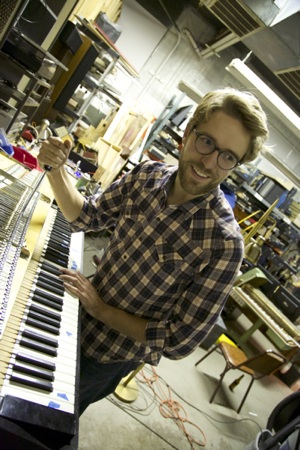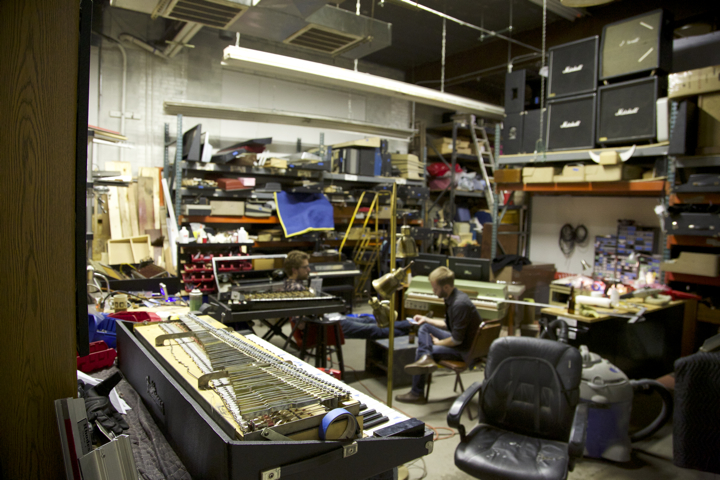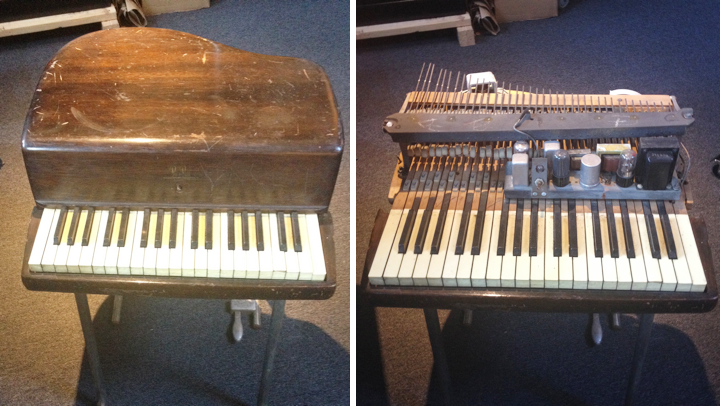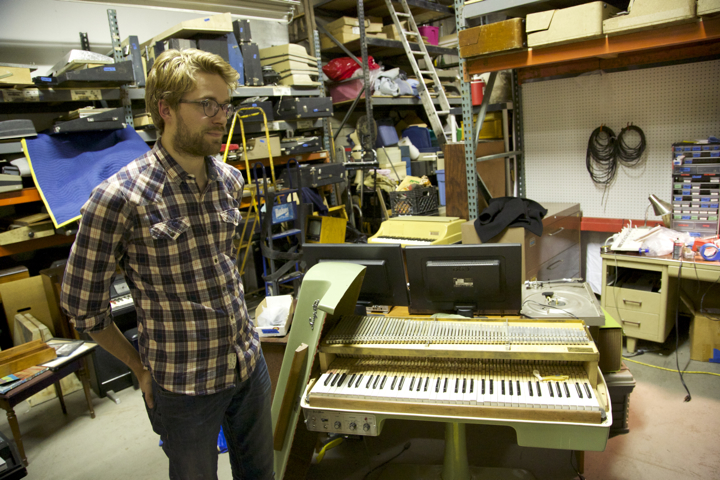A couple of months ago a friend entrusted me with his ’76 Rhodes piano bass. The thing had seen better days. It had unfortunately fallen prey to the evils of basement mold, and I was tasked with damage assessment and hopefully resuscitating it back to a playable condition. While just bringing the object indoors caused my entire apartment to stink like an ancient tomb, I quickly got over the smell and began to dive into the world of the Rhodes electric piano. The construction was simple and intuitive. The disassembling and reassembling process was Zen-like, and I found a wealth of information and collective love of the instrument online.

The amount of literature that exists based on Harold Rhodes’ life, however, is limited. There are tiny blurbs sprinkled about the web referring back to the birth of Harold Rhodes’ first piano design which he created during his service in World War II, but for the most part it is all pretty vague. Thirsting for more, I decided to track someone down that had a bit more experience with his head stuck inside of Harold Rhodes’ beautiful creations to gain some more information and insight.
Max Brink is the owner of Chicago Electric Piano Company and has been working on Rhodes pianos for over ten years.
“This is the mess that is my workshop right now, pianos from floor to ceiling pretty much,” he explains leading me past a concrete room arranged with leather furniture and drums that he is slowly transforming into a studio. An impressive amount of analog recording gear peered down at us from a freshly constructed loft.
“We purchase extra shelves almost every month,” he explained. “We just can’t keep up with how much stuff that’s coming in here right now.”
The walls were stacked with piano parts. Spaced out on the floor were dismembered pianos spread out on tables in a manner that could have reminded Harold Rhodes of a World War II medic tent.
“This is pretty much our bread and butter right here: a Mark I from 1973 and a Wurlitzer 200A from the mid to late '70s. These are the most common keyboards that pass through our shop. Here we have two Vox Continentals; an English one and an Italian one. We’ve got our hands full right now. You guys want a beer?”
Max picked up his first Rhodes when he was 16: a poor, decrepit piano that he rescued by working part time throughout high school and eventually purchasing off of eBay. His first piano would turn out to be in the worst condition he would ever see, which launched him into an accelerated learning process involving scouring forums on the internet and milling over the extensive user manuals that the Rhodes Company produced alongside their pianos.

“They’re like 40 or 50 pages just on all of the basic service stuff, but this one needed a lot more than basic service.”
His local network of musicians hailed the piano for its playability and soon he was servicing Rhodes pianos as a part time job throughout college by posting ads on Craigslist. When he eventually turned his skills to studying the innards of Wurlitzers, Vox’s, and even more obscure vintage keyboards, he established Chicago Electric Piano Company and now works from his own shop full time.
Max starts pointing out random pianos around the warehouse. “That’s Wilco’s, that’s Wilco’s, that’s Wilco’s, they’re probably our biggest client,” he admits laughing. As far as Max is aware he’s worked on every Rhodes piano besides the Mark VII (the controversial model released in 2007) and the Celeste 64 key. “I have yet to see one of those.”
Minus the two models, Max has developed quite a palette for appreciating the flavor of each evolution of the Rhodes. “The sweet spot is between 1972 and 1975. I think that the production really peaked in 1972. I think something happened in late ’72 or early ’73 where some of the workers walked off. There’s a tech named Buz Watson that stamped a bunch of Rhodes in the early 70s. Our top ten pianos are a Mark V from 1984, a Mark II from ’81— instruments from all over the map, but four out of our top ten pianos that have come through our shop are Buz Watson’s from 1972. I haven’t seen his name anywhere after ’72. I can’t find much about him unfortunately.”
As is common with mass production, a quality design is not always assurance of a quality product. I felt this even moreso hearing the way Max used Buzz Watson’s name, as if the technician that assembled the piano was a brand-name itself under the umbrella brand of Rhodes. Aside from maintaining the rights to his own brand of pianos, quality control would turn out to be one of Harold Rhode’s biggest frustrations. He never seemed to fully accomplish the instrument that he envisioned.
“I know it was built out of B-17 bombers, you know, the ‘flying fortress,’” Max explained sharing his own understanding of the Harold Rhodes epic which all began with Rhodes’ design and construction of the Army Air Corp piano, also known as the “Xylette.”
“Soldiers assembled them themselves while they were stuck in the hospital, and then they would play them. It’s a totally different instrument. It’s not an electric instrument; it was like if you had a piano’s action playing wind chimes basically. It was a means of therapy and Harold Rhodes won a medal of honor.”

The therapy was so effective that the instructions to construct a Xylette were authored by Harold Rhodes and allegedly published in the Army Air Force manual #29. Hearing this story I couldn’t help but align the image of a soldier building a piano to a Jedi building a light saber— Harold’s pianos were intended to be more than pieces of materials slapped together on an assembly line. Harold’s company would go on to be purchased and sold from Fender to CBS to Arp and then to Roland, and he seemed to lose creative control.
However, Rhodes’ true passion seemed to lie with the instruction of piano rather than the piano itself. Before Rhodes had even considered designing a piano he developed the “Rhodes Method of Piano,” which he taught at a chain of schools he owned and operated across the nation while he was still in his twenties. Much of his efforts working with Fender and CBS were focused on the production of “classroom system” pianos that would outfit his schools. In the 1960s Harold Rhodes even equipped a fleet of large vans with many of the classroom systems to carry out on-campus demonstrations at educational institutions across the country.
Max has a classroom piano in his shop. It’s a large spaceship-looking Rhodes with an avocado green Plexiglas body. It was the first piano I noticed when we walked in. Despite Harold Rhodes’ personal opinion of his pianos, they are beautiful to look at and to hear.
“This is a Rhodes student piano from ’68, it looks like it’s from The Jetsons. It has the earlier square tone bars and the felt hammer tips. The sound that you get from these tines and the hammers is what you hear on “Let it Be” and “Bitches Brew”. You get a really distinct tone, and they just sound gorgeous. These are incredibly rare. This one has all the original Raymac tines. It was in really rough condition when it came in, but when we’re done it will be one of the best in the world.”

We turn our conversation towards the amplifier installed in the piano.
“It still has the original Jordan amplifier. It ran from the [sparkle tops] era, and then they switched over to the Peterson design.”
Max points out an amplifier that’s been extracted from another piano, and hooks it up to a power source.
“What’s really cool about this one [the Peterson design] is that this one has incandescent bulbs in the tremolo circuit. It looks like a pinball machine.”
He switches the amp on and two orange bulbs start to glow, turning the tremolo speed knob the bulbs softly dim and brighten and alternate from side to side.
“That’s the Peterson design. The tremolo— you just can’t even match it. No one’s going to build a circuit like that anymore.”
The Rhodes piano would go on to see a multitude of different transformations, including digital forms produced by Arp and Roland. Harold’s reactions to the digital forms of his piano were less than positive.
“I’ve seen a couple of them and they’re just garbage synthesizers,” remarked Max. “It’s a pretty simply circuit, but there’s definitely parts in there that just wear down and you can’t really replace. It’s not that great of a synthesizer. You have to really want to have it in your collection to sink money into it you know?”

These days it’s much more common in a live band setting to see keyboardists using digital pianos. The Rhodes or “electric piano” sound is a standard sample built-in to countless models. But for some, the labor of transporting the heavy keyboards to gigs is well worth the authentic tone of the actual Rhodes piano.
“There are some really great samples. The latest [Yamaha] Motif has some amazing samples. They sampled Chick Corea’s Mark V and they just tuned it to a T. You can really push it and get it to bark the way you would expect a Rhodes to bark, but in the end you don’t have the vibrating components. I’ve used this line many times before where I’d say ‘Who the hell would think that a musical instrument would have vibrating components?’ Of course that’s a great idea! I think keyboardists get robbed having all of these pianos that have weighted action being what’s being sought after and then in the end you don’t get anything more than a digital sample being played depending on the velocity that you strike it with. What a bummer! Electric guitar players get an electric guitar, it’s not something that is made to sound like playing a Stratocaster, it is a Stratocaster.”
I’ve personally tripped while carrying an 88 key Rhodes and had the thing smash into my lap and crush my tail bone. In the end I was fine, and I’ll still help any keyboardist carry their Rhodes to any gig any time.
See the Chicago Electric Piano Company's Reverb Shop here.
For more help with a Rhodes, check out www.chicagoelectricpiano.com
Photos by Brian Peyrot
